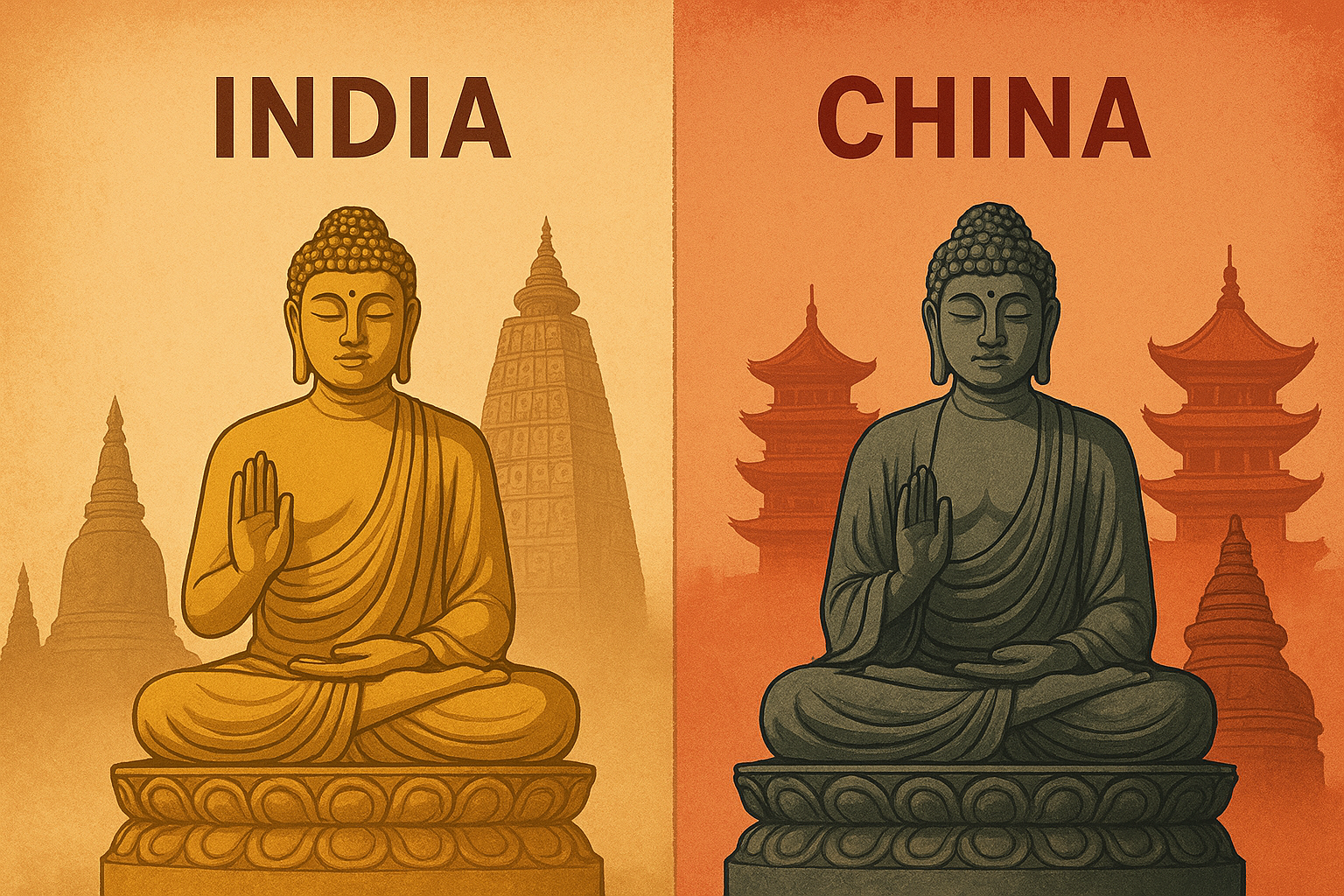Introduction
Buddhism, born over 2,500 years ago in the Indian subcontinent, has re-emerged in the twenty-first century as a powerful tool of diplomacy. Both China and India are harnessing Buddhism’s soft power potential to build cultural bridges and influence regional geopolitics. Yet the two nations’ methods and motivations could not be more different.
While China pursues a state-controlled, strategy-driven campaign to align Buddhism with its foreign policy ambitions, India projects the faith as a civilizational and spiritual heritage, using it to foster unity, peace, and international goodwill.
As recent events show, India’s approach is proving far more credible, inclusive, and sustainable — not only in Asia but across the Buddhist world.
1. China’s Approach: Controlled and Strategic
China’s Buddhist diplomacy operates under tight government supervision. Institutions such as the Buddhist Association of China function directly under the oversight of the United Front Work Department, ensuring that every international Buddhist initiative aligns with Beijing’s political agenda.
Belt and Road Buddhism
Since 2013, the Chinese government has integrated Buddhism into its Belt and Road Initiative (BRI), branding the religion as part of a shared “Asian cultural harmony.” Conferences and temple-building projects in countries such as Sri Lanka, Thailand, and Myanmar often coincide with trade and infrastructure discussions.
While these events create cultural visibility, they are widely perceived as extensions of statecraft rather than genuine spiritual exchange.
Sinicization and Narrative Control
Domestically, Beijing’s “Sinicization of Religion” policy continues to reshape Buddhism under the banner of national ideology. Tibetan Buddhism, in particular, faces restrictions intended to align religious teachings with socialist values. Such policies diminish China’s moral authority in promoting Buddhism abroad, as the faith is often seen as constrained rather than celebrated.
2. India’s Approach: Heritage, Inclusivity, and People Power
India’s strategy could not be more different. Rather than political orchestration, New Delhi emphasizes heritage restoration, interfaith dialogue, and pilgrim connectivity, allowing Buddhism to flourish as a shared human and cultural experience.
Civilizational Continuity
As the birthplace of the Buddha and home to Bodh Gaya, Sarnath, and Kushinagar, India naturally commands spiritual legitimacy. Its outreach builds on this foundation of authenticity — not on manufactured narratives.
Government agencies, private institutions, and Buddhist organizations collaborate to conserve heritage sites, digitize manuscripts, and improve pilgrim infrastructure. Initiatives such as the Buddhist Circuit Tourist Train and Visa-on-Arrival for Buddhist countries have strengthened physical and spiritual connections alike.
The International Buddhist Confederation (IBC)
The International Buddhist Confederation, headquartered in New Delhi, is a cornerstone of India’s Buddhist diplomacy. Supported by the Ministry of Culture, the IBC serves as a global platform for monks, scholars, and practitioners from over 30 countries. It represents an inclusive model — Buddhist-led, not government-controlled — and emphasizes dialogue across all major schools: Theravada, Mahayana, and Vajrayana.
3. Key Developments (2023–2025)
India’s Leadership Initiatives
- Global Buddhist Summit (April 2023, New Delhi): Hosted by the Ministry of Culture and the IBC, the inaugural summit focused on applying Buddhist ethics to modern challenges such as conflict, climate change, and mental well-being. Delegates from Japan, Thailand, Myanmar, Bhutan, and beyond hailed it as a landmark for global Buddhist unity.
- Asian Buddhist Summit (November 2024): Building on that success, India organized the first Asian Buddhist Summit to reinforce regional cooperation, meditation tourism, and inter-monastic collaboration.
- Mahakumbh 2025 Buddhist Exhibition: As part of the world’s largest religious gathering, the IBC curated an exhibition to showcase India’s Buddhist art and relics, attracting millions of visitors.
- Buddha Relic Diplomacy (2025): India sent sacred relics of the Buddha to Kalmykia, Russia, and several Asian nations, a gesture that deepened cultural diplomacy and spiritual fraternity.
- Tri-Service Buddha Circuit Expedition (2025): A unique collaboration between the Indian Armed Forces and the Ministry of Tourism, this motorcycle expedition highlighted Buddhist heritage sites across South Asia, symbolizing India’s harmony between strength and spirituality.
China’s Buddhist Campaigns
- State-Backed Conferences (2023–2025): China organized multiple “World Buddhist Forums” tied to BRI partner countries, positioning itself as a cultural hub. However, participants were largely state-approved institutions.
- Sinicization of Tibetan Buddhism: Continued efforts to integrate Tibetan teachings into state ideology have attracted international concern, challenging China’s portrayal of religious openness.
4. Why India’s Approach Commands Greater Trust
Authenticity and Moral Authority
India’s advantage lies in authenticity. The Buddha was born on the Indian subcontinent, preached across northern India, and achieved enlightenment at Bodh Gaya. The sites that define the religion’s history are within India’s borders, giving it natural legitimacy as the custodian of Buddhist heritage.
Inclusivity Over Ideology
India’s Buddhist diplomacy is plural and open. Events such as the Global Buddhist Summit bring together diverse traditions without political preconditions. The result is a sense of ownership among global Buddhist communities rather than top-down control.
Civil Society and Soft Power
India’s approach empowers monks, scholars, NGOs, and pilgrims to be ambassadors of peace. This contrasts with China’s centralized, bureaucratic messaging. The soft power India gains is organic — rooted in shared experience, not propaganda.
Alignment With Buddhist Values
Buddhism emphasizes compassion, non-violence, and truth — principles mirrored in India’s foreign policy messaging of “Vasudhaiva Kutumbakam” (“The world is one family”). By promoting these values internationally, India transforms spiritual philosophy into actionable diplomacy.
5. Summary Table — Major Buddhist Diplomacy Events (2023–2025)
| Year / Date | Event / Initiative | Location | Organizer / Lead | Purpose / Focus |
|---|---|---|---|---|
| April 2023 | Global Buddhist Summit | New Delhi, India | Ministry of Culture & IBC | Global Buddhist dialogue on ethics and peace |
| November 2024 | Asian Buddhist Summit | New Delhi, India | IBC & Govt. of India | Strengthen Asian Buddhist networks |
| 2024–2025 | Mahakumbh Buddhist Exhibition | Varanasi & Prayagraj | International Buddhist Confederation | Showcase heritage, attract pilgrims |
| 2025 | Relic Transfer to Kalmykia (Russia) | Russia | Govt. of India | Deepen cultural and spiritual diplomacy |
| 2025 | Tri-Service Buddha Circuit Expedition | India & South Asia | Indian Armed Forces & Tourism Ministry | Promote Buddhist heritage and regional unity |
| 2023–2025 | China’s BRI Buddhist Conferences | Various | Buddhist Association of China | Advance state narrative under Belt & Road |
| Ongoing | Sinicization of Tibetan Buddhism | China | Chinese Government | Align Buddhism with socialist ideology |
6. Conclusion
Both India and China view Buddhism as a bridge to regional harmony and a means of extending influence. Yet the spirit of their engagement differs profoundly.
China’s version is a projection of power, meticulously scripted by the state and often intertwined with political objectives. India’s version is a revival of civilizational diplomacy — an invitation to rediscover common spiritual roots.
By centering its Buddhist outreach on authenticity, openness, and mutual respect, India has positioned itself as the world’s most trusted voice in Buddhist dialogue. As New Delhi continues to invest in heritage restoration, global summits, and pilgrim connectivity, it strengthens not only its soft power but also the timeless message of the Buddha — that peace begins with understanding.
References
- International Buddhist Confederation. (2023). Global Buddhist Summit 2023 — Official Proceedings. Ministry of Culture, Government of India.
- Ministry of Culture, Government of India. (2024). Asian Buddhist Summit 2024 Press Release. Press Information Bureau.
- Press Information Bureau. (2025). Mahakumbh Buddhist Exhibition Announcement. New Delhi.
- Ministry of Defence. (2025). Tri-Service Buddha Circuit Expedition: Press Briefing. New Delhi.
- Indian Express. (2025, July). Buddha Relics Sent to Kalmykia Strengthen Cultural Ties.
- Xinhua News Agency. (2024). China’s Buddhist Diplomacy under Belt and Road Initiative. Beijing.
- U.S. Congressional-Executive Commission on China. (2024). Annual Report on Religious Freedom in China. Washington, D.C.
- UNESCO. (2024). World Heritage Sites: Buddhist Monuments in India and China. Paris.



